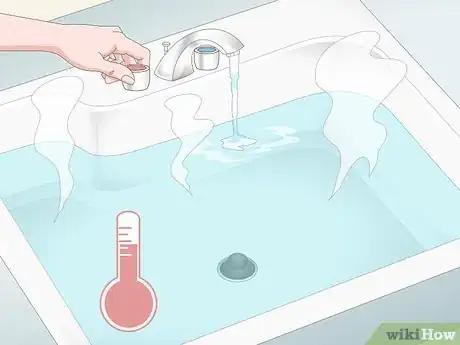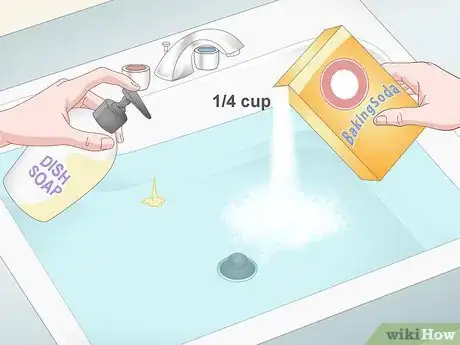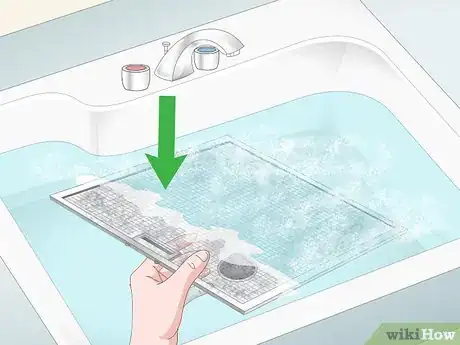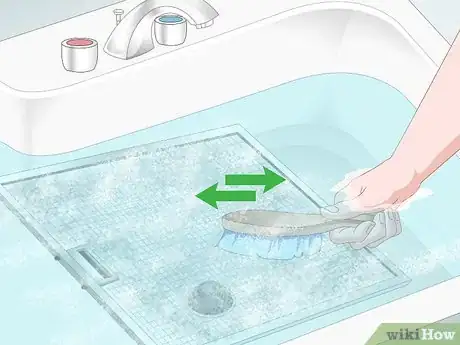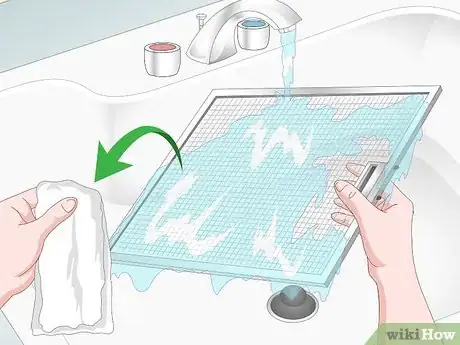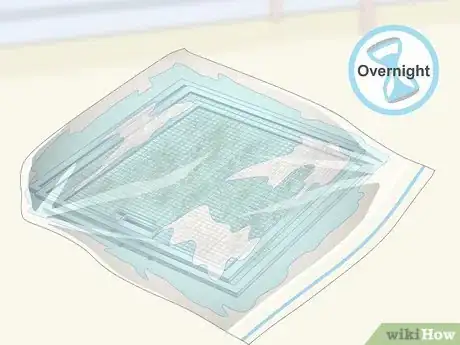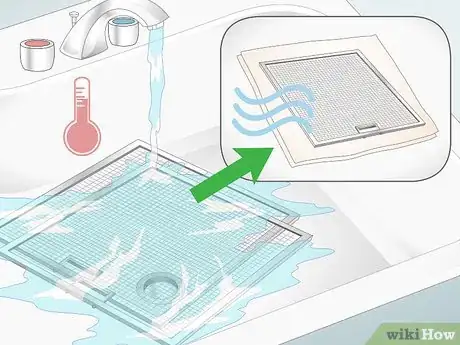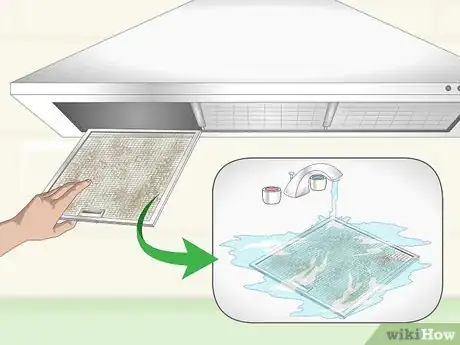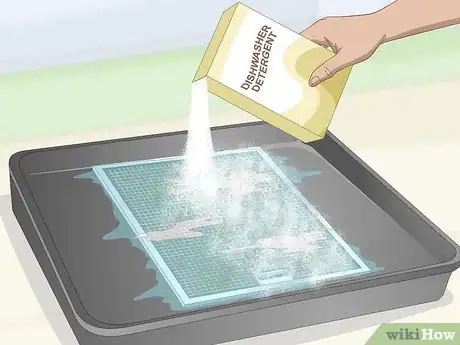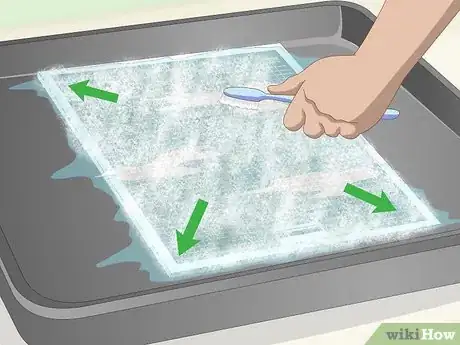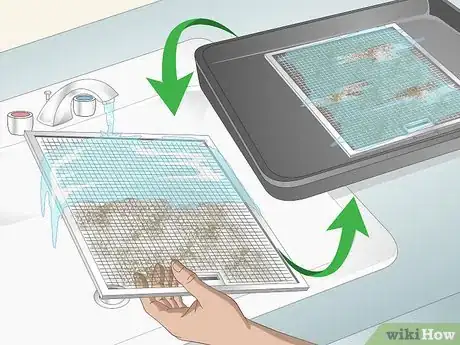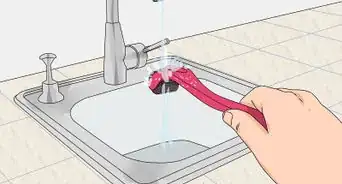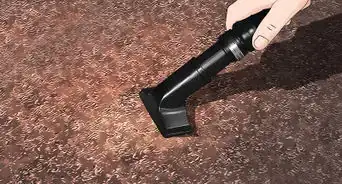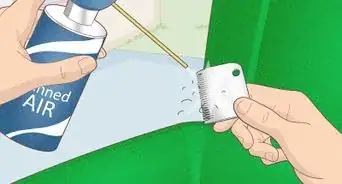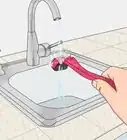This article was co-authored by Michelle Driscoll, MPH. Michelle Driscoll is the Owner of Mulberry Maids, which is based in Fort Collins, Colorado. With five years of experience, her business specializes in cleaning homes and small offices. She holds a Masters in Public Health from the Colorado School of Public Health. Additionally, Mulberry Maids has an A+ rating from the Better Business Bureau.
There are 10 references cited in this article, which can be found at the bottom of the page.
This article has been viewed 26,532 times.
The range hood filter is located in the area over your stove. Its main purpose is to clean the air by preventing the accumulation of grease and food particles. Many people do not realize that these filters need to be cleaned regularly to prevent harmful air pollutants in the home. You can easily clean your filter by soaking them in soap and baking soda or scrubbing them with dishwasher detergent. Whichever method you use, make sure you clean them on a monthly basis to get rid of any buildup that accumulates in the filter.
Steps
Soaking in Liquid Dish Soap and Baking Soda
-
1Remove the filter from the hood. The method for detaching the hood range filter may be different depending on the type and model, but they are all fairly simple. Some are attached with screws, while others have a simple latch mechanism that you need to press and lift to remove. Certain filters have a fastener that you can rotate in and out of position. Figure out how your filter is attached, and remove it prior to cleaning.[1]
- If there is a plastic casing that covers your filter, you'll need to remove that first using a screwdriver before you remove the filter.
-
2Fill your sink with hot or boiling water. Make sure you use a sink stopper so the water doesn't go down the drain. Use hot water only, making sure it gets as hot as possible. Fill the sink up about ¾ of the way.[2]
- If your tap water doesn't get hot enough, boil water in a tea kettle or pot and then pour it in the sink.
Advertisement -
3Pour 1/4 cup (60 g) of baking soda and a squirt of dish soap into the sink. Measure about 1/4 cup (60 g) of baking soda and pour it in. Then, add about 1 tablespoon (15 mL) of degreasing dish soap. Mix the ingredients together until the water is soapy.[3]
- Use a brush to mix the baking soda mixture, especially if you used boiling water, to avoid burning your hands.
- Add 1⁄4 cup (59 mL) of vinegar to the mixture for extra cleaning power.
-
4Put the filter in the sink and let it soak for 10 minutes. If possible, make sure it is fully submerged so that the entire filter gets cleaned at once. Let the filter soak in the hot water for at least 10 minutes to allow the baking soda and dish soap to penetrate tough stains.[4]
- If your filter is on the larger side and doesn't completely fit in the sink, you might need to do one half of your filter at a time.
-
5Scrub the filter with a non-abrasive scrub brush. With the filter still in the sink, scrub the filter to get off any residue. Scrub the entire surface, front and back, to ensure that the filter is completely clean.[5]
-
6Rinse the filter under running water and dry it with a clean cloth. Drain the sink and turn on the hot water to rinse the filter. Use the running water to remove all of the baking soda and dish soap. After it's rinsed, use a clean cloth to dry the filter thoroughly.[6]
- Leave the filter on a towel or dish rack for an hour or so if it needs additional drying.
-
7Replace the filter in the hood once it is dry and wash them monthly. Make sure your filter is completely dry before you put it back into the hood. To keep your filter well maintained, aim for monthly cleanings. This will keep your range hood running effectively and your filter looking its best.[7]
Soaking the Filters in Ammonia
-
1Pour ammonia over the filters in a gallon-sized resealable plastic bag. Place the filters into the bag and pour enough ammonia over them to cover them, or enough to fill the bag about halfway full. Then, close the bag and leave it on a flat surface, such as a counter or table.[8]
- Sealing the filters in a bag with the ammonia will keep the smell of the ammonia contained.
-
2Let the filters soak in the ammonia overnight. The ammonia will break down the grease and clean the filters while they soak. Leave the filters in the ammonia for at least 8 hours or overnight.[9]
- There's no need to scrub the filters or move them around in the ammonia. They will get clean just by soaking.
-
3Rinse the filters under hot running water and let them dry. After time is up, take the filters out of the bag over a sink. Place them into the sink and turn on the faucet to hot. Rinse the filters thoroughly with the hot water to remove all of the ammonia. Then, place the filters on a clean, dry paper towel and let them air dry.[10]
Removing Grease with Dishwasher Detergent
-
1Remove the filter from the hood and wet it with warm water. The warm water allows the dishwasher detergent to better penetrate the grease and other residues on the filter. Rinse both sides of the filter, making sure it is completely drenched in water.[11]
-
2Put the wet filter on a baking pan and cover it with dishwasher detergent. Remove the filter from the sink and put it on a large baking sheet. The filter side with the most grease and residue should be facing up. Then, pour a generous amount of dishwasher detergent all over the filter.[12]
- This will prevent a huge mess on your counter or table space, as long as the baking sheet is larger than the filter.
- Make sure to use dishwasher detergent instead of dishwashing liquid. Dishwasher detergent is a gel cleanser that is only used in the dishwasher, not the liquid soap that is used in the sink.
-
3Use a toothbrush to spread the detergent all over the surface of the filter. Spread the dishwasher detergent on the filter, making sure to cover the edges and the entire surface. Use a toothbrush to evenly distribute the detergent, making sure all of the tiny holes in the filter are covered.[13]
- If you don't have a spare toothbrush, you can also use your fingers to spread the detergent, though that may not be as effective.
-
4Let the detergent sit on the filter for 20 minutes. Leave the dishwasher detergent on the filter to let it penetrate the grease for easy removal. You should let it sit for at least 20 minutes. If your filter is significantly soiled, you will need to soak it for an hour or more.[14]
-
5Rinse the filter with warm water. After letting the filter soak, the dirt and grease on the filter should come off easily in the water. Make sure to rinse both the front and back of the filter to remove all of the debris.[15]
- Use a hose attachment to spray the filter if your sink has one. The water pressure from the hose should be strong enough to remove any accumulation on the filter.
-
6Repeat the cleaning if necessary. If your filter is significantly soiled, you may need to repeat the cleaning process more than one time. There may be some debris still stuck in the filter, especially on the edges. If that is the case, add more dishwashing detergent on the trouble areas, scrub with a toothbrush, and rinse one more time. Any remaining dirt should come off and your filter will be sparkly clean![16]
- Make sure to dry the filter thoroughly before putting it back in the hood. Use a clean towel to dry the front and the back, and let it sit on a dish drying rack for an hour or so if needed.
Warnings
- Fabric and grease filters should not be cleaned. Replace these types of filters every 3-4 months.⧼thumbs_response⧽
- Avoid cleaning your hood range filter in the dishwasher. The odors and the grease will cling to the lining of your dishwasher and get caught in the drain. [17]⧼thumbs_response⧽
- The area around the filter can be a fire hazard if you do not wipe it down regularly. Try to remember to clean it at least once per month with a degreaser.⧼thumbs_response⧽
Things You'll Need
Using Liquid Dish Soap and Baking Soda
- Hot water
- Liquid dish soap
- Baking soda
- Non-abrasive scrub brush
- Dishcloth
Removing Grease with Dishwasher Detergent
- Baking pan
- Dishwasher detergent
- Old toothbrush
References
- ↑ https://dengarden.com/cleaning/how-to-clean-range-hood-filters-5-easy-methods
- ↑ https://www.thekitchn.com/how-to-clean-a-greasy-range-hood-filter-cleaning-lessons-from-the-kitchn-203844
- ↑ https://www.thekitchn.com/how-to-clean-a-greasy-range-hood-filter-cleaning-lessons-from-the-kitchn-203844
- ↑ https://www.thekitchn.com/how-to-clean-a-greasy-range-hood-filter-cleaning-lessons-from-the-kitchn-203844
- ↑ https://www.thekitchn.com/how-to-clean-a-greasy-range-hood-filter-cleaning-lessons-from-the-kitchn-203844
- ↑ https://www.thekitchn.com/how-to-clean-a-greasy-range-hood-filter-cleaning-lessons-from-the-kitchn-203844
- ↑ https://www.thekitchn.com/how-to-clean-a-greasy-range-hood-filter-cleaning-lessons-from-the-kitchn-203844
- ↑ https://housewifehowtos.com/clean/clean-stove-hood-filter/
- ↑ https://housewifehowtos.com/clean/clean-stove-hood-filter/
- ↑ https://housewifehowtos.com/clean/clean-stove-hood-filter/
- ↑ https://youtu.be/H6RxGiwG8cg?t=169
- ↑ https://youtu.be/H6RxGiwG8cg?t=199
- ↑ https://youtu.be/H6RxGiwG8cg?t=219
- ↑ https://youtu.be/H6RxGiwG8cg?t=243
- ↑ https://youtu.be/H6RxGiwG8cg?t=291
- ↑ https://youtu.be/H6RxGiwG8cg?t=508
- ↑ https://youtu.be/k2FltIbCaDk?t=233

